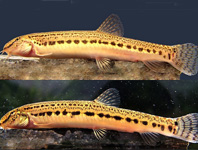Abstract
Two species of Fortuyniidae, found on the Galápagos Islands (Ecuador) are described and illustrated based on the adult and juvenile instars. Alismobates galapagoensis sp. nov. was found on six islands of the archipelago, in littoral and supralittoral habitats. It is morphologically similar to A. inexpectatus Pfingstl & Schuster, 2012 from Bermuda, but differs from that species and all other known congeners by a prominent cuticular ridge on epimeron III among other unique character combinations. Litoribates caelestis gen. and sp. nov. was found on the islands Santa Cruz and Bartolomé in the littoral zone under Maytenus and mangroves. Notes on distribution and ecological preferences of both species are included.
References
Baert, L. (2013) Summary of our present knowledge of the spider communities of the Galápagos archipelago. First analysis of the spider communities of the islands Santa Cruz and Isabela. Belgian Journal of Zoology, 143 (Supplement), 159–185.
Baert, L. & Mahnert, V. (2015) The distribution of the non-araneae and non-acari arachnids of Galápagos. Belgian Journal of Entomology, 28, 1–76.
Hammen, L. van der (1960) Fortuynia marina gen. nov., sp. nov., an oribatid mite from the intertidal zone in Netherlands New Guinea. Zoologische Mededelingen, 37, 1–9.
Hammen, L. van der (1963) Description of Fortuynia yunkeri nov. spec., and notes on the Fortuyniidae nov. fam. Acarologia, 5, 152–167.
Karasawa, S. & Aoki, J. (2005) Oribatid mites (Arachnida: Acari: Oribatida) from the marine littoral of the Ryukyu Archipelago, Southwestern Japan. Species Diversity, 10, 209–233.
Luxton, M. (1992) Oribatid mites from the marine littoral of Hong Kong (Acari: Cryptostigmata). In: Morton, B. (Ed.), The marine flora and fauna of Hong Kong and southern China III. Proceedings of the Fourth International marine Biological Workshop: The marine Flora and Fauna of Hong Kong and Southern China. Hong Kong University Press, Hong Kong, pp. 211–227.
Peck, S.B. (1994) Sea-surface (pleuston) transport of insects between islands in the Galápagos Archipelago, Ecuador. Entomological Society of America, 87, 576–582.
https://doi.org/10.1093/aesa/87.5.576Peck, S.B. (2001) Smaller orders of insects of the Galápagos Islands, Ecuador: Evolution, Ecology, and Diversity. NRC Research Press, Ottawa, Ontario, 278 pp.
Peck, S.B. (2006) The beetles of of the Galapagos Islands, Ecuador: Evolution, Ecology, and Diversity. NRC Research Press, Ottawa, Ontario, 315 pp.
Pfingstl, T. (2015a) Marine associated mites (Acari: Oribatida: Ameronothroidea) of the African continent: biogeography, new species and distribution records. Systematic and Applied Acarology, 21, 320–334.
https://doi.org/10.11158/saa.21.3.7Pfingstl, T. (2015b) The intertidal Fortuyniidae (Acari: Oribatida): new species, morphological diversity, ecology and biogeography. Zootaxa, 3957 (4), 351–382.
https://doi.org/10.11646/zootaxa.3957.4.1Pfingstl, T. & Krisper, G. (2014) Plastron respiration in marine intertidal oribatid mites (Acari, Fortuyniidae and Selenoribatidae). Zoomorphology, 133, 359–378.
https://doi.org/10.1007/s00435-014-0228-5Pfingstl, T. & Schuster, R. (2012) First record of the littoral genus Alismobates (Acari: Oribatida) from the Atlantic ocean, with a redefinition of the family Fortuyniidae based on adult and juvenile morphology. Zootaxa, 3301, 1–33.
Pfingstl, T. & Schuster, R. (2014) Global distribution of the thalassobiontic Fortuyniidae and Selenoribatidae (Acari, Oribatida). Soil Organisms, 86, 125–130.
Schatz, H. (1991a) Arrival and establishment of Acari on oceanic islands. In: Dusbabek, F. & Bukva, F. (Eds.), Modern Acarology. Vol. 2. Academia, Prague and SPB Academic Publ., The Hague, pp. 613–618.
Schatz, H. (1991b) Catalogue of known species of Acari from the Galapagos Islands (Ecuador, Pacific Ocean). International Journal of Acarology, 17, 214–225.
https://doi.org/10.1080/01647959108683909Schatz, H. (1994a) Lohmanniidae (Acari, Oribatida) from the Galapagos Islands, the Cocos Island and Central America. Acarologia, 35 (3), 267–287.
Schatz, H. (1994b) New records of the genus Torpacarus (Acari: Oribatida: Lohmanniidae) from the Galapagos Islands and from Central America. Acarologia, 35 (2), 167–179.
Schatz, H. (1998) Review Oribatid mites of the Galápagos Islands - faunistics, ecology and speciation. Experimental and Applied Acarology, 22, 373–409.
https://doi.org/10.1023/A:1006097928124
Schatz, H. (2001) The genus Eremaeozetes (Acari: Oribatida) on the Galápagos Islands. Acarologia, 41 (4), 475–493. [2000]
Thornton, I.W.B. (1971) Darwin's Islands: A Natural History of the Galapagos. American Museum of Natural History. 1st Edition. The Natural History Press, New York, 322 pp.

